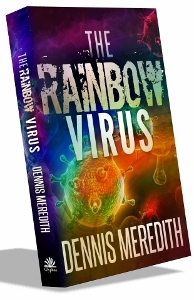The Rainbow Virus
A "Scientific Fiction" Adventure
In the new novel The Rainbow Virus, a bioterrorist has unleashed a frightening epidemic of unknown viruses that turn people colors: red, blue, chartreuse, emerald, pumpkin, fuchsia...
The culprit appears to be a brilliant, eccentric biologist, Arthur Lupo, who vanished from a San Diego biotech company. At first, Lupo seems the most eccentric bioterrorist of all time. The engineered viruses he releases only turn their victims a palette of colors. But then his chief pursuers—disgraced FBI agent Bobby Loudon and obsessive CDC epidemic-tracker Kathleen Shinohara—discover a horrifying fact. The brilliant Lupo has stolen the world's most lethal viruses from the Army's bioterrorism center.

Lupo asserts that his first viruses were only a test. He dramatically proves their infectivity by transforming the citizens of Denver into a rainbow of colors. In a chilling declaration, he announces that he plans to release an unstoppable artificial virus whose spread will decimate the world's population.
Loudon and Shinohara must race against time, a mysterious assassin, and a secret government faction to find Lupo and stop him.
Although Meredith sought to make The Rainbow Virus an entertaining adventure in tone, the message it carries is serious, and based on government bioterrorism documents—which is why he dubs the novel "scientific fiction."
"While I did take quite a few liberties with the science to make it a good story, the fact remains that advances in biotechnology are making bioterrorism more and more likely. I hope readers enjoy the novel, but I also hope it makes them recognize the fact that creating a bioweapon is far easier than building a nuclear bomb." Meredith includes on his web site a list of reports and articles documenting the current state of the bioterrorism threat.
Meredith also used the novel to satirize the peculiar psychological quirk that leads people to judge one another based on skin color. "As a biochemist by training, I've always considered the tendency to classify people by the amount of melanin in their skin to be downright weird," he says. "If that tendency hadn't led to the profound tragedy of racism, it would be considered absurdly funny; like classifying people based on earlobe size.
"What has also fascinated me is that we literally think of race largely in binary terms: black or white. That's the nomenclature we use. But there are no really 'white' people or 'black' people on earth. We're all 'shades of beige,' to borrow from the title of another book.
"So, I decided to explore what would happen if everybody suddenly turned a whole rainbow of colors. It would certainly upset their complacent perceptions of race and skin color."
In writing The Rainbow Virus, Meredith drew on his long experience as a research communicator at leading research universities, including Caltech, MIT, Cornell, Duke and the University of Wisconsin. His previous books include Explaining Research (Oxford University Press 2010).